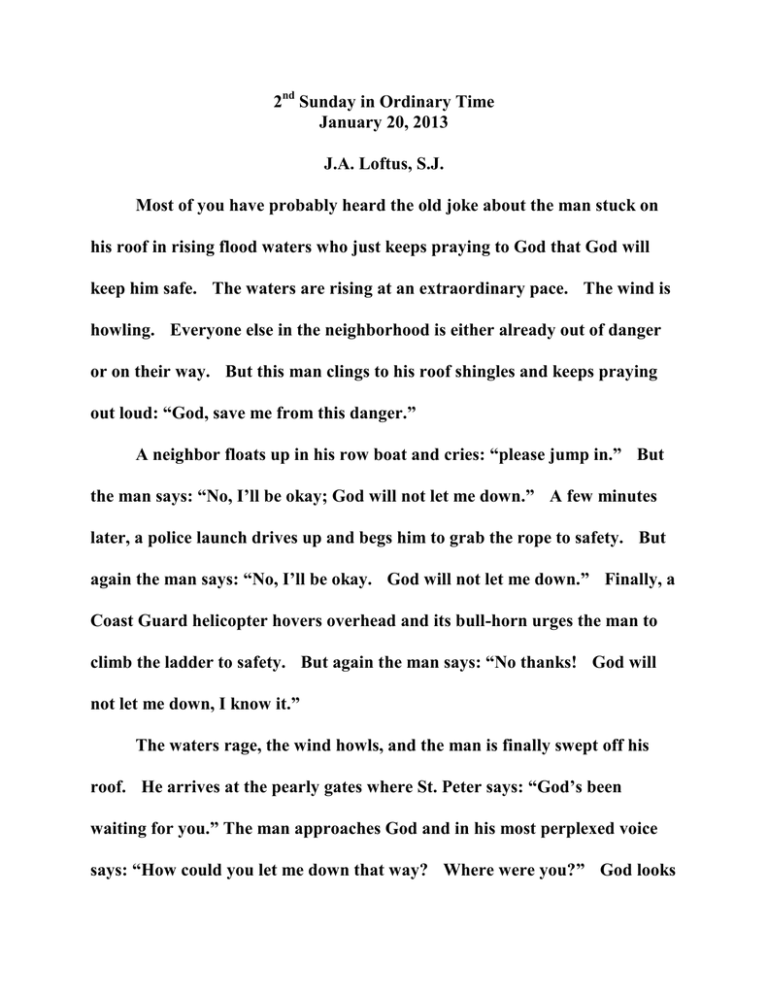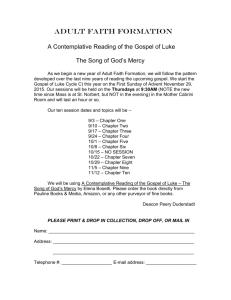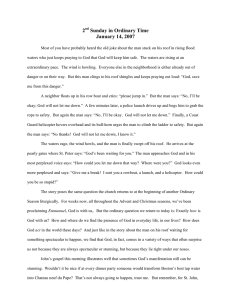2 Sunday in Ordinary Time January 20, 2013
advertisement

2nd Sunday in Ordinary Time January 20, 2013 J.A. Loftus, S.J. Most of you have probably heard the old joke about the man stuck on his roof in rising flood waters who just keeps praying to God that God will keep him safe. The waters are rising at an extraordinary pace. The wind is howling. Everyone else in the neighborhood is either already out of danger or on their way. But this man clings to his roof shingles and keeps praying out loud: “God, save me from this danger.” A neighbor floats up in his row boat and cries: “please jump in.” But the man says: “No, I’ll be okay; God will not let me down.” A few minutes later, a police launch drives up and begs him to grab the rope to safety. But again the man says: “No, I’ll be okay. God will not let me down.” Finally, a Coast Guard helicopter hovers overhead and its bull-horn urges the man to climb the ladder to safety. But again the man says: “No thanks! God will not let me down, I know it.” The waters rage, the wind howls, and the man is finally swept off his roof. He arrives at the pearly gates where St. Peter says: “God’s been waiting for you.” The man approaches God and in his most perplexed voice says: “How could you let me down that way? Where were you?” God looks even more perplexed and says: “Give me a break! I sent you a rowboat, a launch, and a helicopter. How could you be so stupid?” The story poses the same question the church returns to at the beginning of another Ordinary Season liturgically. For weeks now, all throughout the Advent and Christmas seasons, we’ve been proclaiming Emmanuel, God is with us. But the very ordinary question we return to today is: Exactly how is God with us? How and where do we find the presence of God in everyday life, in our lives? How does God act in the world these days? And just like in the story about the man on his roof waiting for something spectacular to happen, we find that God, in fact, comes in a variety of ways that often surprise us not because they are always spectacular or stunning, but because they lie right under our noses. John’s gospel this morning illustrates well that sometimes God’s manifestation still can be stunning. Wouldn’t it be nice if at every dinner party someone would transform Boston’s best tap water into Châteauneuf -du-Pape? That’s not always going to happen, trust me. But remember, for St. John, Jesus’ miracles are not so much about straining or defying the physical laws of nature. The miracles for John are signs, pointers. He says in today’s gospel this “miracle” at Cana was the first of Jesus’ signs. Signs 2 of God’s presence, signs of who this Jesus really is, signs of manifestation, of God’s Theophany. This gospel story is really still a part of the Epiphany celebration, as it is in all the Eastern churches (the old churches founded in Jerusalem, Antioch, Alexandria). It proclaims that God’s signs are all around us. So where are God’s “signs” today? St. Paul offers a fascinating answer in his letter to the Corinth community. He says: “look around at all the different gifts present in your community.” “Look around and see God’s signs, God’s pointers, God’s Epiphany, most often right in front of you.” Some of us are preachers, some prophets, some teachers, some apostles, some look like row-boats, some like police launches, some like Coast Guard helicopters. But we are all trying to sing the same song, God’s song. The image of God’s song was helpful to me in thinking about why John’s gospel calls this “miracle” at Cana the “first sign.” It is like a little piccolo that introduces all the notes and signs and people to come. This is only the “First” sign, John tells us. More music to follow! The insight about the sign being a song was a gift from a man I had never heard of before. His name is Kent Nerburn and he wrote a little book on the Peace Prayer of St. Francis, just called Make Me an Instrument of Your 3 Peace. You all know the prayer. I had never thought of the instrument St. Francis mentions here as a musical instrument. I always thought it meant something like make me an “agent” of your peace, or an instigator, or something like that. But make me like a piccolo, or viola, or drum? Never thought of that! Dr. Nerburn, just like St. Paul, then goes on to describe how important each and every instrument is in a symphony orchestra. Not all are flashy to be sure (think actually of the piccolo or the viola), but without each and every one you never hear what the composer desired. Each instrument is needed in its own time and place or the music is just not what it is supposed to be. The best example that came to my mind was the man in the Boston Pops orchestra who plays the wooden slats in Leroy Anderson’s Sleighride. He makes the sound of the whip cracking above the horses pulling the sleigh. (Ta-da-dum-dum-dum-dum-dum-dum----slap— ta da.) He must wait all year for his big moment. There is not a lot of call for a wooden slat player at other times of the year! But the song would never be the same without that slap. Percussionists sometimes have all the fun! So you want to know how God manifests in our own world every day? Look around and be amazed at just how blessed we are to have such 4 magnificent witnesses to God’s great symphony. God’s theophony is here right in front of us every day. Just listen! And the next time you feel yourself perched on your rooftop as the waters rise perilously around you, don’t be stupid like in the story. Listen for the piccolo and smile. Welcome back to so-called Ordinary Time; maybe it does not need to be quite so ordinary after all. Peace! 5





